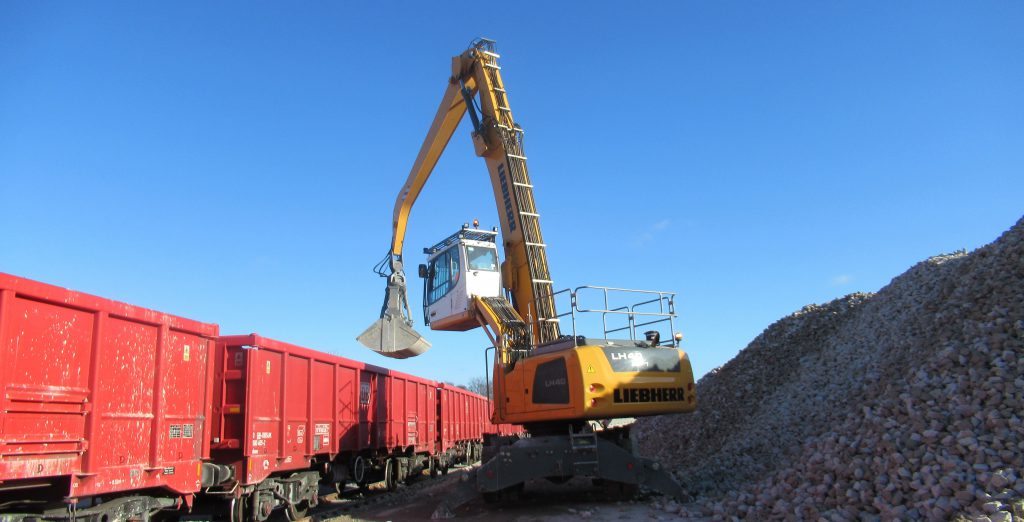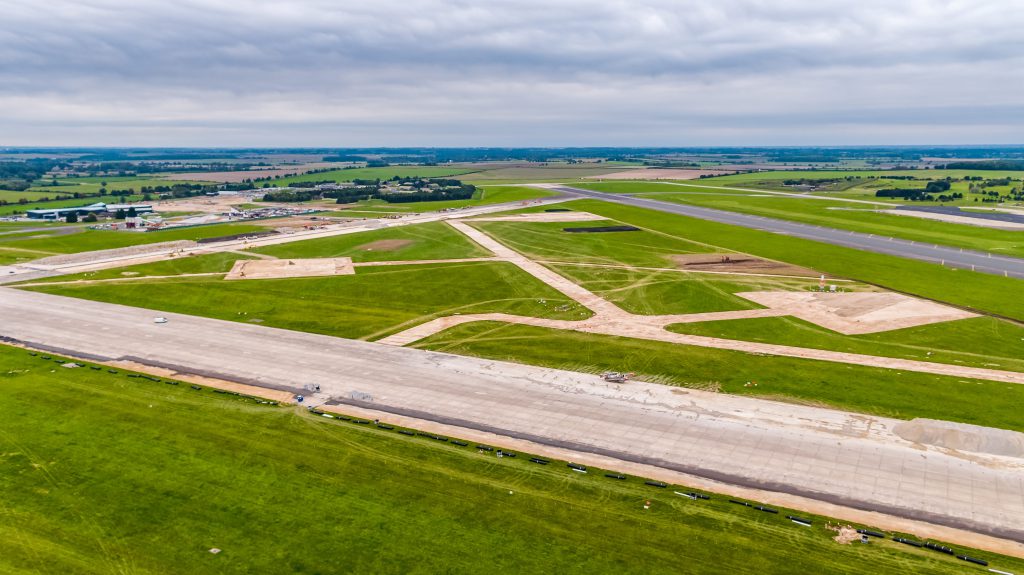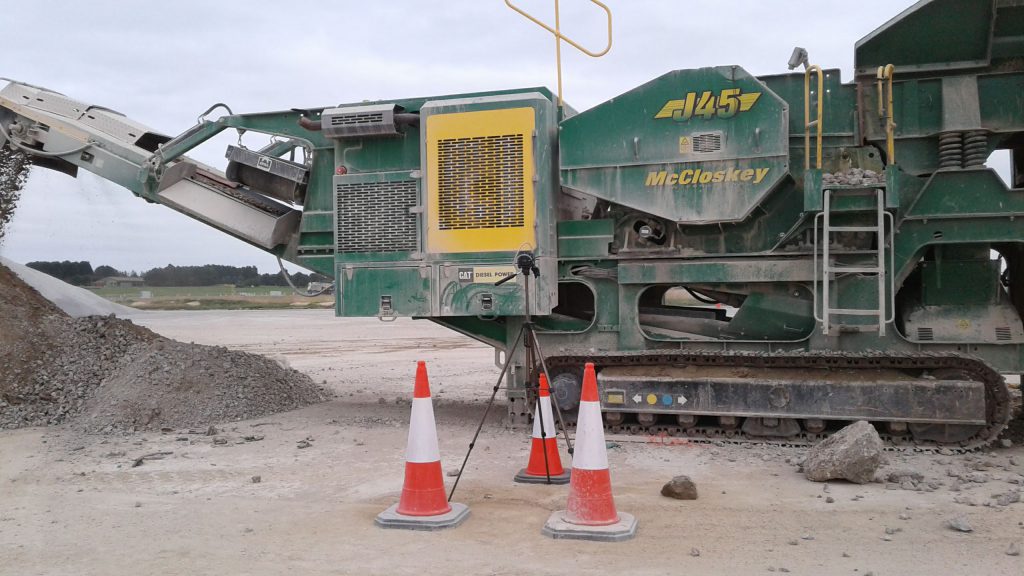CEEQUAL Excellent for RAF Marham Infrastructure Work
Overview
The reconstruction of RAF Marham airfield in Norfolk, UK, involved improving the existing infrastructure and replacing some of the existing facilities. Recognised for its commitment to sustainability, the project team was awarded a CEEQUAL (now known as BREEAM Infrastructure) rating of Outstanding. The works were successfully completed in June 2019, four months ahead of schedule.
About
The Defence Infrastructure Organisation is an operating arm of the Ministry of Defence in the United Kingdom. It is responsible for the built and rural estate.
Background
Project Anvil’s final and main works package, with a construction value of £120 million, involved the reconstruction of RAF Marham airfield. This included the design and construction of a new aircraft hangar with associated support buildings and structures. The improvements are required to meet the operating, technical, communications and security requirements of the new aircraft.


Challenges
The refurbishment of the airfield included the reinstatement of a disused runway, the refurbishment of an active main runway, refurbishment of eleven taxiways, the construction of new aircraft servicing platforms, the construction of new build vertical landing pads, as well as aeronautical ground lighting (AGL).
The works were undertaken during daytime hours and the airfield was required to remain operational throughout, used throughout the construction process by the Tornado GR4 aircraft as well as the F35 Lightning aircraft after May 2018.
The construction was undertaken on an operational military runway, health, safety and security were of paramount importance throughout the project, as was meeting the construction programme for the arrival of the F35.
The key activities and elements of the construction process were the onsite production of concrete and asphalt, as well as the break-out and excavation of existing surfaces requiring refurbishment.
In environmental terms, the key potential impacts of the construction process were considered to be associated with the use and transport of materials for the concrete and asphalt production, the excavated materials arising from the refurbishment process and the clearance of vegetation required for the works.
Solutions
The project requirement was to achieve an Excellent Whole Team award. This requirement bought together the different organisations through regular CEEQUAL workshops. This highlighted the environmental monitoring and environmental management of the construction process, the environmental assessments and reporting, community engagement, stakeholder engagement and consultation and feasibility studies undertaken throughout the project’s development.
The workshops bought together the client (DIO), the client’s representative and organisation responsible for the outline design (AECOM), the organisation responsible for the detail design (Jacobs), the contractor (GTLC) as well as the end user (RAF Marham station) to work together towards an common goal. The strategy was to create a strong team with the client, client’s representative, lead design organisation and contractor.
The aims of the first workshop were implemented throughout the future workshops:
Develop and agree a mission statement for CEEQUAL. The agreed mission statement was ” To Go Beyond Excellent”
Agree strategy to achieve Excellent score
Assign responsibility for achieving individual credits- focusing on credits which overlap/ require collaboration
Agree programme for gathering evidence/ lines of communication
Agree programme for monitoring progress through future reviews
Project strategy
The foundation of the Project Strategy was the MOD and DIO sustainability requirements, policies and methodologies, which were implemented from the feasibility and options appraisal stage of the project.
RAF Marham station lies within a rural area and is surrounded by agricultural land. Community engagement and consultation was carried out by the RAF Marham station throughout the site selection and options appraisal process for this strategic MOD project, ensuring potential impacts on the local community were minimised during construction.
The client representative ensured that all DIO procedures were followed and Sustainability Appraisals were carried out for each stage of the project. Even though the project was screened as a non-EIA project, detailed environmental surveys and assessments, such as ecology and ground conditions had been undertaken prior to construction.
There was a clear auditable trail of the environmental and sustainability considerations of each stage of the decision-making process. In addition, consultation with the Local Planning Authority and agreements to reduce potential disruption from construction impacts were already in place prior to construction.
These requirements were taken forward into the detail design and construction phase, when GTLC developed the client policies and requirements into the project’s environmental management system.
In terms of the CEEQUAL objectives, all CEEQUAL sections were scoped into and included within the assessment process. The project achieved a score of 84.9 % for the Sustainability Performance Rating and greater than 75% in seven of the nine CEEQUAL sections, scoring particularly well in the project management, people and communities, ecology and biodiversity and physical resources sections. The section below summarises some of the key initiatives and measures which contributed to this score.
Project management
The CEEQUAL process was led and assessed by the Project Environmental Lead. This dual role enabled the project’s environmental management system to incorporate the CEEQUAL objectives and targets from the outset. It was ensured that environmental requirements were met through environmental inspections, site audits and daily environmental management. A team of specialists including ecologists (WYG), hydrogeologists (WYG) and air quality specialists (Dust Scan Ltd) provided environmental support throughout the construction process.
Every member of the construction team contributed to the environmental management of the project related to their role: site operatives, foremen, supervisors, the commercial team members, quality assurance managers, HSE manager, design coordinators, project managers and project director.
The airfield design organisation incorporated environmental benefits and improvements compared to the original existing runway in terms of the water environment, operational energy use and the re-use of materials.
GTLC was able to continue the high quality of environmental and sustainability assessments and consultation carried out by the Client, Client’s Representative and RAF Marham Station prior to construction commencement.
People and communities
Community engagement and consultation for Project Anvil was carried out by RAF Marham station throughout all stages of the project’s development. Sustainability Appraisals were carried out for the feasibility, site selection through to the preferred option layout, with engagement carried out with Local Planning Authority.
During construction, excavated materials were crushed and processed on site to produce engineering materials in accordance with the design specification as required. The crushing and screening of concrete and asphalt processing were a potential source of dust emissions on site, a particular challenge given the large quantities to be processed on site.
Independent dust emission measurements carried out at ten locations across the site found that the dust mitigation measures employed by GTLC and all sub-contractors were effective. The results indicated that respirable silica arising from crushing, in-halable dust from screening, respirable dust emissions from the haul routes across the site and PAH emissions within the asphalt plant were within the acceptable limits and that appropriate measures had been taken to manage dust emissions on site.
Additionally, 20 tonnes of wood waste were sent to Community Wood Recycling, a local engagement project, for re-use and recycling, including crates, pallets and timber from trees which requiring removal.
An Environmental Prize competition was set up for the project. The initiative was based on direct contribution to the project environmental management system made by the staff on site. One point was awarded for every environmental action or environmental initiative taken by staff on site, carried out in addition to their day to day duties and role. The two members of staff with the most points in the civil works and building works were awarded a prize each. This helped create a positive culture of environmental management on site and engaged the wider site team.
Ecology and biodiversity
The parcels of land outside the airfield boundary were found to be a potential habitat for ground nesting birds. In order to reduce the potential impacts on habitat loss and ground nesting birds, the areas of vegetation required to be cleared for the approach lighting were reduced from a potential 2.45 hectares to the minimal footprint required to complete the AGL works.
A programme of ecological pre-clearance surveys, ecological watching briefs was implemented to ensure the project was delivered to programme whilst complying with relevant environmental legislation.
Pro-active engagement with the site supervisors by the Project Environmental Lead and ecology team in relation to the construction programme avoided clearance within the bird nesting season as far as possible. Where this was not possible an Ecological Management Plan was implemented.
In order to avoid potential impacts on protected species, ecological mitigation (through pre-clearance surveys), ecological supervision (through on site ecological clerk of works), as well as regular environmental audits were carried out. This ensured that ecological impacts were avoided throughout the works.
A number of active bird nests were found in the vegetation (skylark and partridge nests) and some of the trees requiring removal. Protective measures were put in place to ensure there were no impacts throughout construction until birds fledged the nests.
Regular checks for bird nests were also carried out within the Feeder and Hangar building. A pair of swallows began nesting within the plant room of the Hangar building, the programme was changed to avoid disruptive works until the swallows fledged the nest.
Close collaboration with the DIO forestry department helped ensure that tree removal works were undertaken without impacts on trees of high value or on nesting birds and in line with the requirements of the Forestry Commission. Trees of high value were retained and protected throughout the works.
Despite finding active bird nests during works carried out in the summer, through close collaboration of the site team and the environmental team, the project successfully implemented the Ecological Management Plan and had no impacts on protected species and their habitat.
The RAF Marham station implemented the creation of Ladywood Nature Area as ecological mitigation and enhancement for Project Anvil and in order to replace the trees lost as a result of the wider scheme. The site is located within an area of on RAF Marham station which will not impact the operational safety of the runway. It serves as a wildlife refuge and includes a pond, tree planting with bat boxes and bird boxes, a nature trail, as well as an outdoor classroom and ecological activities for school children. The Ladywood Nature area will be used and managed by RAF Marham station serving the station community in the long term.
Water environment
The detail design incorporated environmental benefits and improvements compared to the original existing runway in terms of the water environment. A site-specific flood risk assessment was carried out by Jacobs as part of the detail design process. Specifically for the squadron area, Jacobs has carried out modelling for storm events up to 1 in 100 years, to protect nearby buildings against flood risk and designed for these storm events.
The design evolved from outline to detailed design, where more onerous 1 in 30 and 1 in 100 years models + 40% climate change were taken into account. To reduce the risk of flooding, larger diameter drainage pipes have been installed in the drainage network in order to increase the attenuation. Flow control devices have been installed to limit the outfall volumes into existing local waterways. Improvements in run-off water quality were implemented and the drainage design includes attenuation, soakaway and oil separators in order to protect the underlying Principal Aquifer.
Physical resources: use and management
The project achieved 100 % diversion from landfill of excavated materials with 320,000 tonnes of arising re-used on site. Excavated materials were crushed or processed on site as required to produce engineering materials in accordance with the design specification.
The processing of excavated materials to produce engineering materials was carried out to meet the requirements set out with the designer’s Earthworks and Bases Design Specification document, as well as the contractor’s Materials Management Plan (approved under the CLAIRE Construction Code of Practice) and the Environment Agency’s Aggregate Protocol and Environmental Permits.
The implementation of recycling of materials was a key element of the construction process, with inputs required across the contractor’s site team, from the quality assurance manager, project environmental lead as well as project managers and the site teams. This was managed through an ongoing Materials Management Plan verification process, using the onsite laboratory to ensure engineering materials met the design and environmental specifications.
The reuse of materials has also provided environmental benefits in terms of avoiding the use of virgin aggregates. This achievement not only exceeded the MOD target of 70% diversion from landfill but provided environmental benefits through avoiding the environmental impacts associated with hauling 320,000 tonnes of soils and virgin aggregates to site.
The project team proposed the use of 6.6 amps LED for all AGL primary circuits versus traditional 12 amps tungsten halogen lamps for runways and 6.0 Amps for other AGL. This was accepted and implemented in construction.
From a technical point of view, the use of LED offers significant benefits for infrastructure compared with the traditional tungsten halogen lighting systems. The main advantages are the lower operating costs of LED fixtures due to their longer life-span, as well as lower energy consumption of the LED lighting due to the significant reduction of the fixtures power demand.
Using LED, the energy consumption during the operation of the refurbished airfield will be reduced to between 50% and 90%. LED fittings also provide longer life compared with tungsten halogen, reducing the ongoing maintenance requirements.
The construction team implemented the use of five solar powered tower lights for use during night works. The solar powered lighting columns were used during the construction of hangar building avoiding the use of diesel generators in indoor spaces and were also used to light the batching plant area leading to improvements in indoor and local air quality, reduction in noise levels, as well as a reduction in total diesel use and manpower for refuelling. The solar powered lights worked sufficiently during the winter months in Norfolk, reducing reliance on diesel generators across the site.
All timber procured was required to be from sustainable sources, in line with the UK Government Timber Procurement Policy or from a recycled source. The policy states that only timber and wood-derived products originating from an independently verifiable legal and sustainable source should be specified. This includes all virgin timber and wood-derived products used in the permanent and temporary works.
The construction team implemented a fuel use and energy management plan for the construction phase, which set out objectives and targets and how these would be implemented, monitored and achieved. We identified prior to project commencement that the greatest fuel and energy demand during construction would arise from the onsite asphalt batching plant. We set and achieved clear targets to ensure that the efficiency of the asphalt plant was maintained throughout operation as well as fuel targets for vehicles and other plant.
Transport
GTLC was faced with a logistical and environmental challenge as the project required the delivery of 241,147 tonnes of aggregates to the site for the on-site production of concrete and asphalt. This would have required the haulage of aggregates from Dove Holes quarry in Derbyshire, more than 230km from RAF Marham, using an estimated 8612 return lorry (HGV) journeys.
In response to the challenge, the project enabled the reinstatement an abandoned rail freight station, which had been disused for a number of years. Based on a privately funded initiative, the appointed haulage company has reinstated rail sidings at Brandon station. The re-instatement enables freight trains to transport aggregates directly from Dove Holes quarry to Brandon, connecting CEMEX Dove Holes quarry with East Anglia.
Brandon is located 30 km from RAF Marham, reducing the total distance required to be travelled by lorries by 87%. This has greatly reduced the road freight, reduced environmental impacts associated with traffic impacts, reduced congestion and fuel use and demonstrated that economic drivers can stimulate more environmentally sustainable construction initiatives.
In addition, a carbon calculation carried out for the project identified that the carbon emissions (in terms of greenhouse gas as carbon dioxide) of using the combination of freight train and HGV in place of HGV for the entire route, were halved.
HGV delivering aggregate from Brandon freight station to the site collected excess asphalt arising from the runway refurbishment, returning them to the Brandon freight station materials sorting facility for re-use on other construction projects. This provided the additional environmental benefits of reducing empty HGV journeys, the diversion of material from landfill as well as reducing the amount of raw materials used in other construction projects.
The creation of a circular economy and the processing of excavated materials as engineering materials enabled a closed loop in the construction of the project. The project demonstrates a success story in the circular economy. Each freight train removes 55 HGV from the roads, the use of Brandon freight station will continue, providing additional benefits in the future.


Benefits
The independent verification and ratification process which CEEQUAL requires has provided external recognition for the environmental and sustainability achievements of Project Anvil and the team. It provides an industry wide benchmark for infrastructure and encouraged the project to go beyond environmental regulation, standard environmental management systems and contractual requirements, encouraging innovation. Speaking on the success of the project, James Aikman, Project Director GTLC JV, Project Anvil, shared, “GTLC JV is delighted to have received an Excellent in the CEEQUAL award for the delivery of Project Anvil. GTLC has led the environmental management of the detail design and construction phase, as well as the CEEQUAL assessment process and the team is delighted to receive this external recognition from CEEQUAL.” He continued, “The key sustainability elements of the project included 100% diversion of excavated materials from landfill, the use of a freight train to transport aggregates to site and the pro-active environmental management across the team. The award represents going beyond environmental compliance to achieve distinction in environmental and sustainability performance.” |


